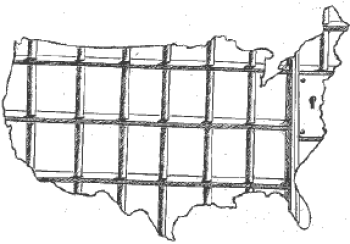|
|
|
![]()
|
PRISON
* NATION
|

|
By Vincent Schiraldi and Jason Ziedenberg Justice Policy Institute ONCE WE dust off our keyboards and realize our computers still work, Americans will have to deal with the real Y2K problem facing this country. By Valentinets Day of the year 2000, America will achieve the dubious distinction of having more than 2 million of its citizens behind bars. The 1990s could be dubbed "the punishing decade,' as the 800,000 jail and prison inmates we added dwarf all previous decades when our incarceration rates rose and fell with changes in our economy and population. America's imprisonment binge has been so massive and so sudden that it is difficult for many people to comprehend, but a few startling facts spell out the scale of what we are doing with our prisons and jails. America, with less than 5 percent of the world population, has a quarter of the world's prisoners. There are six times as many Americans behind bars as are imprisoned in the 12 countries that make up the entire European Union, even though those countries have 100 million more citizens than the United States. Our jails and prisons have become the 51st state, with a greater combined population than Alaska, North Dakota and South Dakota. According to one Justice Department survey, one in three African-American boys born today will spend some time in prison in their lifetime. The connection between incarceration and crime is as elusive at the end of the 1990s as it has been in previous decades. The South continues to be the region of the country with both the highest incarceration rates and the highest crime rates. New York, which led the nation in declining rates of violent crime, had the second slowest growing prison system in the country between 1992 and 1997, and the population of the city's jail system actually declined during that time. As we enter the new millennium, the ascendance of prisons as our decde1s major public works project and social program is a sad but preventable legacy. Although prison expansion is sold on the specter of Jack the Ripper, we are increasingly locking up the Three Stooges. Two-thirds of the inmates in America's prisons and jails -- over 1.2 million prisoners -- are locked up for non-violent offenses. While the number of violent offenders doubled from 1980, the number of non-violent prisoners has tripled and the number of drug prisoners has increased seven-fold. The challenge for leaders in the 21st Century will be to restore balance to a system that has overrercted. That will mean creating programs and punishment options -- like drug treatment, restitution centers and intensive supervision -- which hold less serious offenders accountable for their behavior without crushing them and without breaking the bank. In the final analysis, the measure of our system should not be how many Americans we lock up, but how few Americans are victimized. ( Vincent Schiraldi and Jason Ziedenberg are analysts with the Justice Policy Institute in Washington. They wrote this column for the Pacific News Service. ) **ln accordance with Title 17 U.S.C. section 107, this material is distributed without charge or profit to those who have expressed a prior interest in receiving this type of information for non-profit research ** Graphic by Braulio Castellanos, Pelican Bay State Prison |